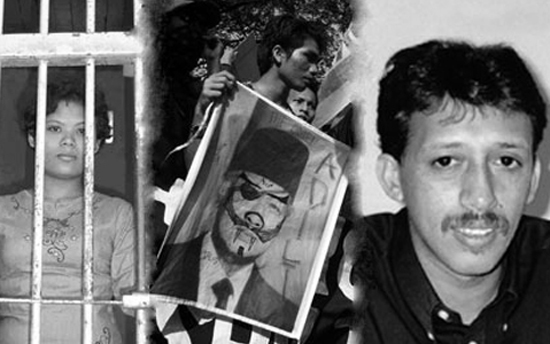
Carmel Budiardjo of TAPOL
Historians have recorded many massacres that occurred during the 20th century but few mention the massacres in Indonesia that took place during 1965-1966, which paved the way for Soeharto to seize power in 1965.
For six months from October 1965, the Indonesian military, aided by anti-communist gangs, perpetrated killings on a nationwide basis. The majority of those slaughtered were villagers dragged from their homes, who were tortured and then killed. The true scale of the massacres may never be known but the political and social consequences were profound.
All left of centre political institutions were destroyed and the three-million strong Indonesian Communist Party (PKI) and related organisations were banned, with a military regime being installed that was to last more than 30 years.
No one, least of all the relatives of those who survived, dared to speak of what had happened. During Soeharto’s New Order, Indonesians were kept in the dark and even today, the 1965 tragedy is rarely mentioned, which is why this book, Palace of Souls: How Women Struggled Against Torture, by Putu Oka Sukanto is important.
The author calls his book a historical novel. It is easy to read and focuses on how women coped during the years of the tragedy.
Putu Oka Sukanta, a novelist, filmmaker and commentator on social and political affairs and a practising acupuncturist was himself imprisoned for 10 years. The opening chapters relate to the experiences of young people who, in the pre-1965 days, had joined organisations, hoping that they could help to usher in a better future for people living in poverty and ignorance.
Maria is in love with Lasono but her father, a PKI member, calls this an unsuitable match because her boyfriend is a church-goer and member of a nationalist organisation. Then suddenly, their world is shattered by an event that leads to violent upheavals throughout Indonesia; the G30S (September 30 Movement) when six generals and a young soldier were killed and their bodies thrown down a well.
Crack down
As the commander of RPKAD, the army’s elite unit, Soeharto mobilised forces to crack down on the communists and their associates, having determined that the PKI was responsible for the murders.
Top-ranking communists were rounded up and killed along with their alleged sympathisers. Tens of thousands were arrested and accused of being involved without a shred of evidence.
Torture was rife and prison conditions were atrocious.
All newspapers were banned except those controlled by the military.
The bodies of the generals had allegedly been mutilated. It was alleged that members of Gerwani, a left-wing women’s organisation, had engaged in obscenities with the bodies.
These fabrications, which incited fury against Gerwani, were instrumental in inciting people to join in the killings.
Media controlled
With all the media under military control, these fabrications were never refuted.
As Putu Oka writes:
“Like water flowing from one town to another, fury against the PKI spread everywhere and helped to trigger the killings. These lies from Jakarta were repeated, stigmatising the PKI and Gerwani and other organisations that were regarded as being close to the PKI. Thousands were rounded up and thrown into prison.”
In Jakarta, where I was living at the time, army trucks could be seen transporting poorly clad men, their hands clasped behind their heads, speeding towards unknown destinations. Puka Oka writes:
“The flames were spread by the army from kampung to kampung, all over the country, engulfing everyone in their path, accusing without legal process, explanation or evidence. It was as if the land had been soaked in benzene, engulfing everyone."
Women, whose husbands had disappeared, spent weeks trying to find their loved ones. Thereafter, the women took food to prisons though they could rarely meet the prisoners.
Meeting each other daily, standing for hours in the blazing heat, they shared information about who was where, who had been transferred and whether anyone needed medicine.
Women adapted
Bereft of their men, Putu Oka describes how women developed new skills, starting up little businesses to sell cakes or make clothes.
Like so many others, Maria’s mother now had to earn a living.
But things were to get worse. On 29 July 1969, the book depicts many women were congregating outside prisons in Jakarta, the prisoners had been told to pack their bags for a journey to an unknown destination.
“The prisoners were waiting for the hour of departure. Some had left their blocks while others were waiting in their blocks. This was how they were treated, always in uncertainty.”
The women watched the men come out and get on trucks, unable to see their faces. This was the first batch exiled to Buru Island, a sparsely populated, barren island thousands of kilometres away.
The number of prisoners banished to Buru from Java and elsewhere has never been established but it was probably around 15,000. After a tortuous journey, they arrived in Buru, started building barracks and digging the soil to plant rice for their own survival.
Many fell ill or suffered injuries with virtually no medical facilities available. No one knows how many men died there from heat exhaustion, disease or injuries.
Putu Oka Sukanta’s account of these terrible events is a powerful reminder of the pressing need for the historical truth about 1965 to be acknowledged and the pernicious ongoing discrimination against surviving victims and their families to end.
This review was first published in the Jakarta Post.
Carmel Budjiardo's profile page at TAPOL
This work is licensed under a Creative Commons Attribution-NonCommercial 3.0 New Zealand Licence.
 BOOK REVIEW: Istana Jiwa: Langkah Perempuan di Celah Aniaya (Palace of Souls: How Women Struggled Against Torture), by Putu Oka Sukanta. Lembaga Kreatifitas Kemanusiaan 2012, 323 pages.
BOOK REVIEW: Istana Jiwa: Langkah Perempuan di Celah Aniaya (Palace of Souls: How Women Struggled Against Torture), by Putu Oka Sukanta. Lembaga Kreatifitas Kemanusiaan 2012, 323 pages.




